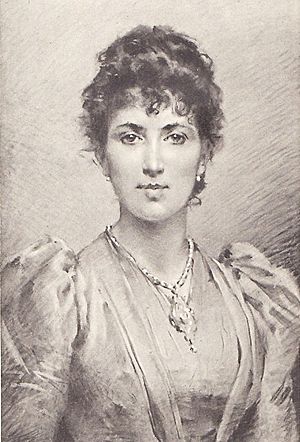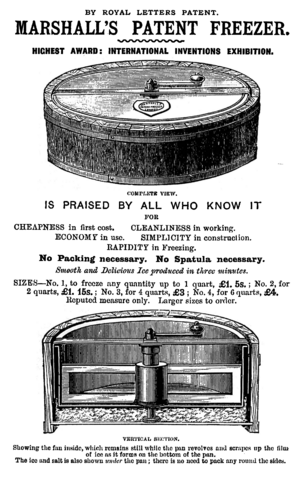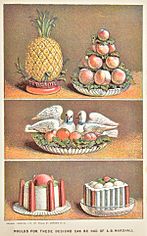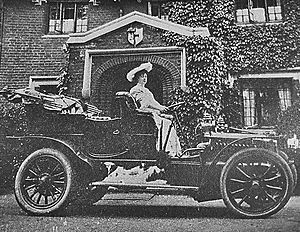Agnes Marshall facts for kids
Quick facts for kids
Agnes B. Marshall
|
|
|---|---|

Engraved portrait published in Mrs A. B. Marshall's Larger Cookery Book of Extra Recipes (1891)
|
|
| Born |
Agnes Bertha Smith
24 August 1855 Walthamstow, Essex, England
|
| Died | 29 July 1905 (aged 49) |
| Nationality | English |
| Occupation | Cook, inventor, entrepreneur |
| Spouse(s) | Alfred William Marshall |
| Children | 4 |
| Signature | |
Agnes Bertha Marshall (born Smith; 24 August 1855 – 29 July 1905) was an English businesswoman, inventor, and famous cook. She was very successful for her time. Marshall was especially known for her work with ice cream and other frozen treats. In Victorian England, people called her the "Queen of Ices."
Marshall helped make ice cream popular in England when it was still new. Many people think she invented the modern ice cream cone. Her ideas might be why ice cream looks and tastes the way it does today.
We don't know exactly when or where Marshall learned to cook. Some writings suggest she learned from chefs in England, France, and Austria. She started her career in 1883 by opening the Marshall's School of Cookery. This school taught fancy English and French cooking and became very famous.
Marshall wrote four popular cookbooks. Two of them were all about ice cream and desserts. With her husband, Alfred, Marshall ran many different businesses. From 1886, she published her own magazine called The Table. It had weekly recipes and articles written by Marshall. She loved new technology and even invented several kitchen machines.
Even though she was one of the most famous cooks of her time, Marshall was mostly forgotten after she died. But in the late 1900s, people rediscovered her work. Her inventions, like her ice cream freezer and the idea of using liquid nitrogen to make ice cream, are popular again today.
Contents
Agnes Marshall's Early Life
Agnes Bertha Smith was born on 24 August 1855 in Walthamstow, Essex. Her father, John Smith, was a clerk. Not much is known about her parents or her early childhood. We know she had at least one brother and that her father died when she was young.
After her father passed away, her mother, Susan, married Charles Wells. They had four more children. One of them, Ada, later worked as Marshall's housekeeper.
It's not clear how or where Agnes learned to cook. An old newspaper article said she had "made a thorough study of cookery since she was a child." It also mentioned she practiced in Paris and with famous chefs in Vienna. In her first book, Marshall wrote that she had "practical training and lessons, through several years, from leading English and Continental authorities."
She married Alfred William Marshall on 17 August 1878. They had four children: Ethel (born 1879), Agnes (called "Aggie," also born 1879), Alfred (born 1880), and William (born 1882).
Her Businesses and Books
Marshall's School of Cookery
Agnes Marshall was a very strong businesswoman. In January 1883, she and her husband bought a cooking school in London. They renamed it the Marshall's School of Cookery. It was unusual for a woman to own a business like this back then.
The school taught fancy English and French cooking. It quickly became one of the two main cooking schools in London. A year after opening, Marshall taught classes with up to 40 students several times a week. Within a few years, the school had almost 2,000 students. Famous experts taught cooking classes there. For example, an English colonel taught how to make curry. A graduate from Le Cordon Bleu taught French cooking.
The Marshalls also sold cooking equipment. They had an agency that found household staff for people. They even had a food shop that sold flavorings, spices, and syrups.
The Book of Ices
In 1885, Marshall wrote and published her first book, The Book of Ices. It had 177 different recipes for ice cream and desserts. She published it herself through her cooking school. The book was well-written and had many pictures. It also showed off some of Marshall's inventions, like the Marshall's Patent Freezer. Critics liked The Book of Ices, but it was mostly noticed by local newspapers.
The Marshall's Patent Freezer was a special machine. It could freeze a pint of ice cream in less than five minutes. Her design was faster and more reliable than many modern electric ice cream makers. Marshall also designed over a thousand different molds for ice cream. She invented an "ice-breaking machine" and an "ice cave," which was an insulated box for storing ice cream. Her company sold these and other kitchen tools and food ingredients.
The Table Magazine and A Pretty Luncheon Tour
From 1886, Marshall and her husband published a weekly magazine called The Table. It was about "Cookery, Gastronomy [and] food amusements." Every issue had a new recipe from Marshall. For the first six months, she also wrote weekly articles on many different topics. These articles were often funny and clever. She wrote about hobbies like riding and gardening. She also criticized her rival cooking school. Marshall even wrote about improving working conditions for kitchen staff in rich homes.
In 1887, Marshall planned to publish her second book, Mrs A. B. Marshall's Book of Cookery. To reach more people, she went on a promotional tour across England. She called it A Pretty Luncheon. The tour helped promote her new book, her cooking school, and her businesses. Marshall cooked meals in front of large crowds, helped by her assistants.
A Pretty Luncheon started in August 1888. She performed in cities like Birmingham, Manchester, and Glasgow. Her shows in London in October were very successful and praised by everyone. Because the first part of the tour went so well, Marshall did a second part in the autumn and winter. She cooked for audiences in many more cities, like Brighton and Liverpool. Some of her shows had 500 to 600 people watching. This tour made Marshall "the most talked about cook in England."
Later Books and Predictions
After some delays, Mrs A. B. Marshall's Book of Cookery was published on 12 May 1888. This book was a huge success. It sold over 60,000 copies and was printed fifteen times. This book made Marshall one of the most important cooks in England. In Book of Cookery, Marshall mentioned putting ice cream in an edible cone. This is the earliest known mention of ice cream cones in English. Her cone, which she called a "cornet," was made from ground almonds. It might have been the first portable ice cream cone you could eat. Marshall's cornet was different from modern cones and was meant to be eaten with a spoon. But she is often seen as the inventor of the modern ice cream cone.
In the summer of 1888, Marshall visited the United States. Her lecture got a good review in a newspaper there. Marshall also provided Christmas dinners for the poor in London in 1889. She gave warm soup to the poor throughout that winter too.
Her third book, Mrs A. B. Marshall's Larger Cookery Book of Extra Recipes, came out in 1891. It was dedicated to Princess Helena of the United Kingdom. This book had more advanced recipes. Marshall's fourth and last book, Fancy Ices, was published in 1894. It was a follow-up to The Book of Ices. Marshall's cookbooks had her own recipes. She always made sure to try out every recipe herself before printing it. Her books also have the earliest known recipe for Cumberland rum butter.
In the 1890s, Marshall started writing weekly articles for The Table again. She wrote about serious and fun topics. She complained about bad food on trains and at railway stations. She spoke out against canned food. She also supported women's rights and guessed about future technology. Marshall made some correct predictions. She thought cars would "revolutionise trade" and help people travel. She imagined refrigerated trucks delivering fresh food across the country. She also predicted that large stores would replace small shops. Marshall was very interested in new inventions. Her shop was one of the first to use things like the dishwasher and automatic doors.
Death and Legacy
In 1904, Marshall fell from a horse. She was injured and never fully recovered. She died the next year, on 29 July 1905, at her home called The Towers in Pinner. Marshall was cremated, and her ashes were buried in Paines Lane Cemetery. Her husband, Alfred, remarried within a year. Their son Alfred died in 1907, and his ashes were buried next to Marshall's. The elder Alfred died in 1917, and his ashes were also buried next to Marshall's in 1920.
Marshall was one of the most famous cooks and food writers of the Victorian age. She was especially known for her ice cream recipes. Her recipes were famous for being detailed, simple, and accurate. Because of her work with ice cream, she was called the "Queen of Ices." Before Marshall, there was only one known book about ice cream in England. She helped make ice cream popular when it was still new. She did this with her portable ice cream freezer and the ice cream cone.
Before Marshall's ideas, ice cream was often sold frozen onto metal rods. You had to lick it off and return the rod. Only rich people usually ate ice cream. Marshall made ice cream so popular that more ice had to be brought into England from Norway. In 1901, she was the first person to suggest using liquid nitrogen to freeze ice cream. She thought this would be the best way to make ice cream quickly. It would also create tiny ice crystals, which was desired.
Even though she was famous when she was alive, Marshall's reputation faded after her death. Her husband continued their businesses, but they struggled without her energy. In 1921, the company was sold, and in 1954, it closed. Marshall's cooking school stayed open until World War II. The Table magazine also continued for a while. Many of Marshall's personal papers were destroyed in a fire in the 1950s, which made her even more forgotten.
However, since the late 1900s, Marshall's fame has returned. She is now seen as one of the most important cooks of the Victorian age. Cookery writers have called her "the famous Mrs Marshall" and "the greatest Victorian ice cream maker." One expert said she was a "unique one-woman industry" whose achievements were "arguably unequalled."
Today, Marshall's books are being printed again. Ice cream freezers based on her designs are also being used. Using liquid nitrogen to freeze ice cream has become a popular trend. In 2014, an ice cream shop inspired by Marshall's idea opened in St. Louis, Missouri. It was named "Ices Plain & Fancy" after her book.
See also
 In Spanish: Agnes Marshall para niños
In Spanish: Agnes Marshall para niños






